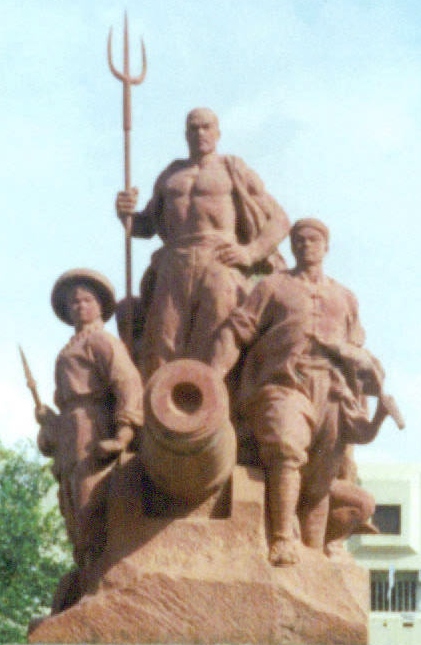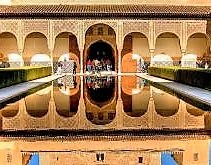RESISTANCE TO IMPERIALISM
Maybe we have the idea that Imperialism and, above all, conquest of territories was an easy task for the Western powers, but sometimes it wasn't so easy.
Try to guess who these people were:
a) Tell me why I have put these two pictures talking about resistance to Imperialism.


b) Who were these soldiers? From where were they? Why have I used this picture talking about resistance to Imperialism?

c) Who is this man? Why have I used this picture talking about resistance to Imperialism? Which book did he eat hoping his cure of apoplexy? What did he use as a throne? By whom was his country conquered?

Try to guess who these people were:
a) Tell me why I have put these two pictures talking about resistance to Imperialism.


b) Who were these soldiers? From where were they? Why have I used this picture talking about resistance to Imperialism?

c) Who is this man? Why have I used this picture talking about resistance to Imperialism? Which book did he eat hoping his cure of apoplexy? What did he use as a throne? By whom was his country conquered?



The first photo shows us an image of the opio , between England and China(1839-1842).
ReplyDeleteThe second photo shows us Daoguang Emperor who was the sixth king who ruled over China(1820-1850) and who had the power during the opio war
The third photo shows us some soldiers from Rajput Regiment, which is an infantry regiment of the Indian Army.
The last photo shows Menelik II, who was the emperor of Etiopia, he had a very important role during the european imperialism in 19th century, meanwhile some northen african countries were fallen, he could mantain independence in his country due to his reforms. Refering to the book, he ate some pages of the Bible. He used electric chair as his imperial throne.
A) Because they partcipated in two opium war between United Kingdom and France against the imperialism.
ReplyDeleteB) Where soldiers of the rajput regiment. They were from India. Because they fought against the imperialism during the first and the second world war.
C) Is Menelik the second emperator of Etiopoia. Because he change his city from a series of semi-independent states, in a united nation. He ate the book of the kings. He used as a throne an electric chair. Etiopia was not conquered by any other country.
Hello everyone, these are my answers:
ReplyDeletea) This two images refer to the series of conflicts between China and the UK during the Imperialism era: the First Opium War (1839-1842). In these, UK was trying to invade China, but the Asian country resisted. Then, British grew opium in India (one of their most important colonies) and exported it to China illegaly. This supposed a great problem for Chinese emperor Daoguang (second picture), that tried to end up with opium in his territory. After some diplomacy and a Second Opium War, the UK won by making China to stablish a profitable trade system with them.
b) On this image, we can see the Rajput Regiment, an Indian army created by the British government during their colonial occupation. It was formed up initially by different Indian ethnies soldiers: Rajputs, Brahmans, Bengalis, Jats… It was an important division for the UK as it supposed infantry support for their war actions in Asia.
c) The man depicted on this picture is Menelik II, the Ethiopian emperor between 1889 and 1909. Ethiopia, known as Abyssinia at that time, was the only country in Africa with Liberia that maintained its independence and kept the European powers away from the rule. However, it was finally conquered by Mussolini (Italy) in 1936, much after the Imperialism era. Although these stories may be false, there are some anecdotes that affirm Menelik II ate pages from The Bible's Books of Kings in order to cure his apoplexy. What's more, he even used an electric chair as a throne, because of the miss of a vital fact: in Ethiopia there wasn't electricity when he ordered three of them in order to show power to his country.
1 guerras del opio
ReplyDeletea) The first picture is a statue which represents the heroes of the Opium Wars.
These were two wars between China and the British Empire.
China was an isolated empire who didn't want occidental ideas entered in their territories. So the
British Empire started to sell Opium illegally to the chinese peasant first, and then they sold it to the
chinese workers. When the Chinese Emperor heard about that, he banned Opium and deported
brithish traders. Then the British Empire attacked China.
China lost the two Opium Wars and in the first one China lost Hong-Kong and in the second one
China had to open their ports and had to pay a lot of money to the British Empire.
The person in the second picture is prince Gong. During the second Opium War the emperor
ordered two of his princes to negociate with England and France, during the meeting the represents
of England and France were kidnapped. Gong wasn't agree with that and he signed the Convention
of Beijing.
You have put these pictures because Chinese people try to resist to the British Emire, and although
they didn't were conquered, they had to accept many conditions of the british.
B) These men were Indian soldiers. You have put this picture because India was invaded by the
British Empire.
India tried to liberate in many ocasions and finally in 1950 the Indian Republic started.
One of the most important figures of the Indian resistance was Mahatma Ghandi.
c) This man was Menelik II. He was Emperor of Ethiopia.
In 1984 Italy invaded Ethiopia and the two countries started a war. Ethiopia won and it was
declared and independt country
guerras del opio
ReplyDeletea) The first picture is a statue which represents the heroes of the Opium Wars.
These were two wars between China and the British Empire.
China was an isolated empire who didn't want occidental ideas entered in their territories. So the
British Empire started to sell Opium illegally to the chinese peasant first, and then they sold it to the
chinese workers. When the Chinese Emperor heard about that, he banned Opium and deported
brithish traders. Then the British Empire attacked China.
China lost the two Opium Wars and in the first one China lost Hong-Kong and in the second one
China had to open their ports and had to pay a lot of money to the British Empire.
The person in the second picture is prince Gong. During the second Opium War the emperor
ordered two of his princes to negociate with England and France, during the meeting the represents
of England and France were kidnapped. Gong wasn't agree with that and he signed the Convention
of Beijing.
You have put these pictures because Chinese people try to resist to the British Emire, and although
they didn't were conquered, they had to accept many conditions of the british.
B) These men were Indian soldiers. You have put this picture because India was invaded by the
British Empire.
India tried to liberate in many ocasions and finally in 1950 the Indian Republic started.
One of the most important figures of the Indian resistance was Mahatma Ghandi.
c) This man was Menelik II. He was Emperor of Ethiopia.
In 1984 Italy invaded Ethiopia and the two countries started a war. Ethiopia won and it was
declared and independt country
a)The second photo refers to the chinese emperor during the Opium War, basically in GB it wasn´t allowed to produce opium so they used China as a place to plant and grow their opium and then sell it, they could because China was a colony of Great Britain.
ReplyDeleteb)The third photo shows a group of the Rajput army, from India, because India was a colony of Great Britain and they were following the wishes of GB
c)This man is Menelik II, he was an emperor of Ethiopia, which was a independent country in Africa only Libera and Ethiopia were independent, he got ill and died because of and overdose of "I Kings", he used an electric chair as his throne, his country was conquered by Tewodros II.